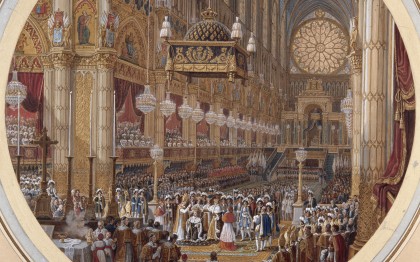As a living symbol of the alliance between spiritual and temporal power, the Cathedral occupies a place all its own in the French popular imagination. But despite being scene of coronations, in Reims, as well as the repository of the pomp and ceremony of all things royal – Te Deum, baptisms, and weddings – it did not survive the revolutionary period unscathed. In 1792, the interior of Notre-Dame de Paris was sacked, and the sculptures in the gallery of the Kings of Judah, deemed to represent the French dynasty, were decapitated.
Under the Empire, the building experienced its first rehabilitation. Napoleon was crowned Emperor at Notre Dame in 1804, and the cathedral’s forecourt was festooned with the flags of the regiments setting out in conquest of Europe. The coronation of Charles X in Reims on 29 May 1825 was a deeply symbolic event, the restoration of the rite itself seen as representing the rehabilitation of the monarchy. As in all mediaeval ceremonies, the cathedral was richly decorated, both the façade – decked out in troubadour-style blue –and the interior of the sanctuary.
The Second Empire, then the Republic, made full use of the monument’s symbolic stature. But during these troubled times, the Cathedral took on yet another dimension: in 1795 Alexandre Lenoir of the Museum of French Monuments brought together all the statues and tombs saved from the iconoclastic wave: the Gothic atmosphere of the scene, frequented by so many artists and writers contributed to the rise of the Romantic sensibility and thus became a starting point for a reform of all the arts.

